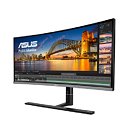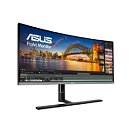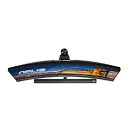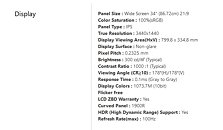Raevenlord
News Editor
- Joined
- Aug 12, 2016
- Messages
- 3,755 (1.15/day)
- Location
- Portugal
| System Name | The Ryzening |
|---|---|
| Processor | AMD Ryzen 9 5900X |
| Motherboard | MSI X570 MAG TOMAHAWK |
| Cooling | Lian Li Galahad 360mm AIO |
| Memory | 32 GB G.Skill Trident Z F4-3733 (4x 8 GB) |
| Video Card(s) | Gigabyte RTX 3070 Ti |
| Storage | Boot: Transcend MTE220S 2TB, Kintson A2000 1TB, Seagate Firewolf Pro 14 TB |
| Display(s) | Acer Nitro VG270UP (1440p 144 Hz IPS) |
| Case | Lian Li O11DX Dynamic White |
| Audio Device(s) | iFi Audio Zen DAC |
| Power Supply | Seasonic Focus+ 750 W |
| Mouse | Cooler Master Masterkeys Lite L |
| Keyboard | Cooler Master Masterkeys Lite L |
| Software | Windows 10 x64 |
ASUS today released the latest into their line of ProArt monitors, especially geared for professionals, where color accuracy is paramount. The ProArt PA34VC features a 21:9 aspect ratio over a 3440 x 1440 IPS panel, which guarantees double the widescreen space of conventional 1080p monitors. The panel already comes factory-calibrated, so there's no need to mix things up in post-buy tinkering (though it does support ASUS' ProArt Calibration Technology,
There's HDR 10 VESA certification with 100% sRGB color gamut coverage, dual Thunderbolt 3 ports for video connectivity and data-transfers at speeds of up to 40 Gbps. These Thunderbolt ports also enable Power Delivery of up to 60W to external devices. It also features built-in Picture-in-Picture (PiP) and Picture-by-Picture (PbP). Gray-to-gray response time is being rated at 0.1ms, according to ASUS, while typical brightness caps out at 300 cd/m².





View at TechPowerUp Main Site
There's HDR 10 VESA certification with 100% sRGB color gamut coverage, dual Thunderbolt 3 ports for video connectivity and data-transfers at speeds of up to 40 Gbps. These Thunderbolt ports also enable Power Delivery of up to 60W to external devices. It also features built-in Picture-in-Picture (PiP) and Picture-by-Picture (PbP). Gray-to-gray response time is being rated at 0.1ms, according to ASUS, while typical brightness caps out at 300 cd/m².





View at TechPowerUp Main Site





